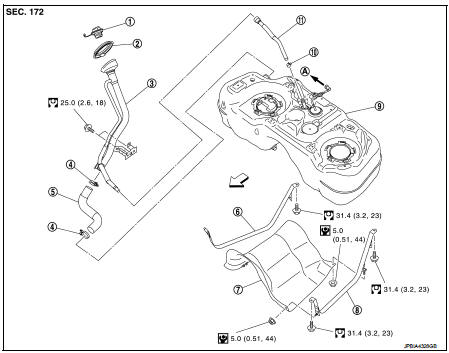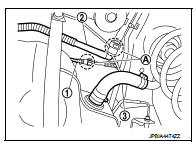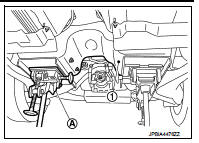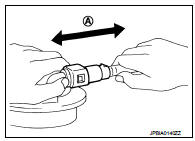Nissan Juke Service and Repair Manual : Fuel tank
2WD : Exploded View

1. Fuel filler cap
2. Grommet
3. Fuel filler tube
4. EVAP canister hose
5. Fuel tank mounting band (RH)
6. Fuel tank mounting band (LH)
7. Fuel tank
8. Clamp
9. Fuel filler hose
10. Vent hose
 Vehicle front
Vehicle front
 : N?·m (kg-m, ft-lb)
: N?·m (kg-m, ft-lb)
2WD : Removal and Installation
WARNING:
Be sure to read ???General Precautions??? when working on the fuel system. Refer to
FL-3, "General Precautions".
REMOVAL
1. Drain fuel from fuel tank if necessary. Refer to FL-6, "2WD : Removal and Installation".
CAUTION:
• Because fuel tank forwardly inclines and becomes unstable when
installing/removing, fuel
should be drained if found the remaining quantity.
• Situate vehicle on a flat and solid surface.
2. Remove RH rear wheel.
3. Perform steps 2 to 7 of ???REMOVAL??? in ???FUEL LEVEL SENSOR UNIT, FUEL FILTER AND FUEL PUMP ASSEMBLY??? on fuel level sensor unit, fuel filter and fuel pump assembly. Refer to FL-6, "2WD : Removal and Installation".
4. Remove center muffler. Refer to DLN-121, "Exploded View".
5. Remove insulator on vehicle side located above center and main mufflers.
6. Move parking brake cable from the lower face of fuel tank. Then remove clips for parking brake cable.
7. Remove brake tube protector.
8. Disconnect fuel filler hose at fuel tank side.
1 : Filler tube
2 : Vent hose
3 : Filler hose

9. Remove vent hose at RH rear wheel well side
10. Remove EVAP hose (1) at front side of fuel tank (2).
 : Vehicle front
: Vehicle front

• Remove quick connector in the following procedures.
- Pinch quick connector square-part (A) with your fingers, and pull out the quick connector (1) by hand.
- If quick connector and tube on vehicle are stuck, push and pull several times until they move, and pull out.
CAUTION:
• The tube can be removed when the tabs are completely
depressed. Never twist it more than necessary.
• Never use any tools to disconnect quick connector.
• Keep the resin tube away from heat. Be especially careful when welding near the tube.
• Prevent acid liquid such as battery electrolyte, etc. from getting on the resin tube.
• Never bend or twist resin tube during installation and disconnection.
• To keep the connecting portion clean and to avoid damage and foreign materials, cover them completely with plastic bags or something similar.
• Never insert plug, preventing damage on O-ring in quick connector.


11. Remove EVAP hose (1) in the back for fuel tank side.
 : Vehicle front
: Vehicle front

12. If necessary, remove mounting screw and quick connectors and slide the EVAP canister rearward to remove it from the fuel tank.
13. Disconnect EVAP hose and vent tube at the position shown in the figure.
• Instruction for quick connector of EVAP hose and vent tube, refer to the following:

Vent tube
• Remove quick connector in the following procedures.
- Pinch quick connector square-part (A) with your fingers, and pull out the quick connector (1) by hand.
- If quick connector and tube on vehicle are stuck, push and pull several times until they move, and pull out.
CAUTION:
• The tube can be removed when the tabs are completely
depressed. Never twist it more than necessary.
• Never use any tools to disconnect quick connector.
• Keep the resin tube away from heat. Be especially careful when welding near the tube.
• Prevent acid liquid such as battery electrolyte, etc. from getting on the resin tube.
• Never bend or twist resin tube during installation and disconnection.
• To keep the connecting portion clean and to avoid damage and foreign materials, cover them completely with plastic bags (A) or something similar.
• Never insert plug, preventing damage on O-ring in quick connector.


14. Support the center part of fuel tank (1) with transmission jack (B).
CAUTION:
Securely support the fuel tank with a piece of wood (A).

15. Remove fuel tank mounting bands (RH and LH).
16. Lower transmission jack carefully to remove fuel tank while holding it by hand.
CAUTION:
Fuel tank may be in an unstable condition because of the shape of fuel tank
bottom. Never rely on
jack too much. Be sure to hold tank securely.
INSTALLATION
Note the following, and install in the reverse order of removal.
Fuel Tank 1. Temporarily tighten bolts [except (2)] in numerical order as shown in the figure.
A : Under view
 : Vehicle front
: Vehicle front

2. Tighten bolt (2) to specified torque, pressing fuel tank in the
direction (  ) shown in the
) shown in the
figure.
3. Tighten bolts [except (2)] to specified torque in the reverse order as shown in the figure.
Fuel Filler Hose
• Surely clamp fuel hose insert fuel filler hose to the length below.
Fuel filler hose : 35 mm (1.38 in) The other hose : 25 mm (0.98 in)
• Be sure hose clamp is not placed on swelled area of fuel filler tube.
• Install fuel filler hose to fuel tank, paying attention to install mark. Marking faces downward.
• Tighten fuel filler hose clamp so that the remaining length of screw thread becomes to the following.
Fuel filler tube side : 8 - 12 mm (0.28 - 0.43 in) Fuel tank side : 5 - 9 mm (0.25 - 0.35 in)
EVAP Hose and Vent Tube 1. Check connections for damage or foreign material.
2. Align the matching side connection part with the center of shaft, and insert connector straight until it clicks.
3. After connecting, pull out quick connector and centralized under floor piping by hand. Check connections are secure.
A : Pull

2WD : Inspecti
INSPECTION AFTER INSTALLATION
Use the following procedure to check for fuel leakage.
1. Turn ignition switch ???ON??? (with engine stopped), and check connections for leakage by applying fuel pressure to fuel piping.
2. Start engine and rev it up and check there are no fuel leakage at the fuel system tube and hose connections.
4WD : Exploded View

1. Fuel filler cap
2. Grommet
3. Fuel filler tube
4. Clamp
5. Fuel filler hose
6. Fuel tank band (RH)
7. Protector
8. Fuel tank band (LH)
9. Fuel tank
10. Clamp
11. Vent hose
A. To EVAP canister
 Vehicile front
Vehicile front
 : N?·m (kg-m, ft-lb)
: N?·m (kg-m, ft-lb)
 : N?·m (kg-m, in-lb)
: N?·m (kg-m, in-lb)
4WD : Removal and Installation
REMOVAL
WARNING:
Be sure to read ???General Precautions??? when working on the fuel system. Refer to
FL-3, "General Precautions".
CAUTION:
• Because fuel tank forwardly inclines and becomes unstable when
installing/removing, fuel should be
drained if found the remaining quantity.
• Situate vehicle on a flat and solid surface.
1. Drain fuel from fuel tank if necessary.
2. Perform the steps 2 to 7 of ???REMOVAL??? in ??? FUEL LEVEL SENSOR UNIT, FUEL FILTER AND FUEL PUMP ASSEMBLY???. Refer to FL-11, "4WD : Removal and Installation".
3. Remove center muffler.
4. Remove propeller shaft. Refer to DLN-121, "Exploded View".
5. Remove protector from fuel tank.
6. Remove fuel filler hose (3) at fuel tank side.
1 : Vent tube
2 : EVAP hose
 : Vehicle front
: Vehicle front

7. Disconnect vent hose connector (1).
8. Disconnect vent tube and EVAP hose at rear side of fuel tank.
• Instruction for quick connector (A) of EVAP tube and vent hose. Refer toFL-11, "4WD : Removal and Installation".

9. Remove parking brake cable mounting bolts. Refer to PB-4, "Exploded View".
10. Disconnect ABS harness connector from fuel tank mounting band.
11. Support left of fuel tank (1) with transmission jack (A), and them remove fuel tank band (RH) (2).
10. Clamp
11. Vent hose
A. To EVAP canister
 Vehicile front
Vehicile front
 : N·m (kg-m, ft-lb)
: N·m (kg-m, ft-lb)
 : N·m (kg-m, in-lb)
: N·m (kg-m, in-lb)
4WD : Removal and Installation
REMOVAL
WARNING:
Be sure to read “General Precautions” when working on the fuel system. Refer to
FL-3, "General Precautions".
CAUTION:
• Because fuel tank forwardly inclines and becomes unstable when
installing/removing, fuel should be
drained if found the remaining quantity.
• Situate vehicle on a flat and solid surface.
1. Drain fuel from fuel tank if necessary.
2. Perform the steps 2 to 7 of “REMOVAL” in “ FUEL LEVEL SENSOR UNIT, FUEL FILTER AND FUEL PUMP ASSEMBLY”. Refer to FL-11, "4WD : Removal and Installation".
3. Remove center muffler.
4. Remove propeller shaft. Refer to DLN-121, "Exploded View".
5. Remove protector from fuel tank.
6. Remove fuel filler hose (3) at fuel tank side.
1 : Vent tube
2 : EVAP hose
 : Vehicle front
: Vehicle front
7. Disconnect vent hose connector (1).
8. Disconnect vent tube and EVAP hose at rear side of fuel tank.
• Instruction for quick connector (A) of EVAP tube and vent hose. Refer toFL-11, "4WD : Removal and Installation".

9. Remove parking brake cable mounting bolts. Refer to PB-4, "Exploded View".
10. Disconnect ABS harness connector from fuel tank mounting band.
11. Support left of fuel tank (1) with transmission jack (A), and them remove fuel tank band (RH) (2).

12. Support right of fuel tank(1) with transmission jack (A), and them remove fuel tank band mounting bolts (LH).

13. Supporting with hands, descend transmission jack carefully, and remove fuel tank.
CAUTION:
Fuel tank may be in an unstable condition because of the shape of fuel tank
bottom. Never rely on
jack too much. Be sure to hold tank securely.
INSTALLATION
Note the following, and install in the reverse order of removal.
Fuel Filler Hose
• Insert fuel filler hose to the length below.
: 35 mm (1.38 in)
• Be sure hose clamp is not placed on swelled area of fuel filler tube.
• Tighten fuel filler hose clamp so that the remaining length of screw thread becomes to the following.
Fuel filler tube side : 7 - 11 mm (0.28 - 0.43 in) Fuel tank side : 5 - 9 mm (0.20 - 0.35 in)
EVAP Hose
1. Check connections for damage or foreign material.
2. Align the matching side connection part with the center of shaft, and insert connector straight until it clicks.
3. After connecting, pull out quick connector and centralized underfloor piping by hand. Make sure connections are secure.
A : Pull

4WD : Inspection
INSPECTION AFTER INSTALLATION
Use the following procedure to check for fuel leakage.
1. Turn ignition switch “ON” (with engine stopped), and check connections for leakage by applying fuel pressure to fuel piping.
2. Start engine and rev it up and check there are no fuel leakage at the fuel system tube and hose connections.
 Fuel level sensor unit, fuel filter
and fuel pump assembly
Fuel level sensor unit, fuel filter
and fuel pump assembly
2WD : Exploded View
1. Fuel tank
2. Lock ring
3.
Fuel level sensor unit, fuel filter and
fuel pump assembly
4. Rock ring
Vehicle front
: N?·m (kg-m, ft-lb)
: Always replace after every ...
 Evap canister
Evap canister
2WD : Hydraulic Layout
EVAPORATIVE EMISSION LINE DRAWING
1.EVAP canister purge volume control
solenoid valve
2. EVAP canister
3. EAVP line
4. Fuel line
NOTE:
Do not use soapy water or any t ...
Other materials:
Additional service when replacing control unit
ECM
ECM : Description
Performing the following procedure can automatically activate recommunication
of ECM and BCM, but only
when the ECM is replaced with a new one*.
*: New one means a virgin ECM that has never been energized on-board.
(In this step, initialization procedure by CONSULT-I ...
Components
• THE LARGE ILLUSTRATIONS are exploded views (see the following) and
contain tightening torques, lubrication
points, section number of the PARTS CATALOG (e.g. SEC. 440) and other
information necessary to
perform repairs.
The illustrations should be used in reference to service matters only. ...
Diagnosis system (BCM)
Common item
COMMON ITEM : CONSULT-III Function (BCM - COMMON ITEM)
APPLICATION ITEM
CONSULT-III performs the following functions via CAN communication with BCM.
SYSTEM APPLICATION
BCM can perform the following functions for each system.
NOTE:
It can perform the diagnosis modes except the ...
